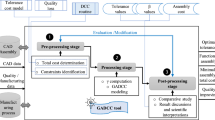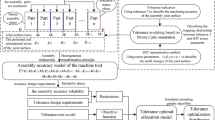Abstract
An important problem that faces design engineers is how to assign tolerance limits. In practical applications, tolerances are most often assigned as an informal compromise between functionality, quality and manufacturing cost. Frequently, the compromise is obtained iteratively by trial and error. A more scientific approach is often desirable for better performance. In this paper, a genetic algorithm (GA) is used for the design of tolerances of machine elements to obtain the global optimal solution. The objective is to design the optimum tolerances of the individual components to achieve the required assembly tolerance, zero percentage rejection of the components and minimum cost of manufacturing. The proposed procedure using GA is described in this paper for two tolerance design optimization problems: gear train and overrunning clutch assemblies. Results are compared with conventional techniques and the performances are analyzed.
Similar content being viewed by others
References
Chang T-C (1990) Expert process planning for manufacturing. Addison-Wesley, Boston
Michael W, Siddall JN (1982) The optimal tolerance assignment with less than full acceptance. ASME J Mech Des 104:855–860
Lee WJ, Woo TC (1990) Tolerances: their analysis and synthesis. J Eng Ind 112/113:113–121
Gadallah MH, ElMaraghy HA (1994) A new algorithm for discrete tolerance optimization. Proceedings, Fourth International Conference on Computer Integrated Manufacturing and Automation Technology, IEEE Computer Society Press, pp 292–297
Choi H-GR, Park M-H, Salisbury E (2000) Optimal tolerance allocation with loss functions. J Manuf Sci Eng Trans ASME 122:529–535
Cho B-R, Kim YJ, Kimbler DL, Phillips MD (2000) An integrated joint optimization procedure for robust and tolerance design. Int J Prod Res 38:2309–2325
Feng C-X, Wang J, Wang J-S (2001) An optimization model for concurrent selection of tolerances and suppliers. Comput Indust Eng 40:15–33
Kopardekar P, Anand S (1995) Tolerance allocation using neural networks. Int J Adv Manuf Technol 10:269–276
Dupinet E, Balazinski M, Czogala E (1996) Tolerance allocation based on fuzzy logic and simulated annealing. J Intell Manuf 7:487–497
Ji S, Li X, Ma Y, Cai H (2000) Optimal tolerance allocation based on fuzzy comprehensive evaluation and genetic algorithm. Int J Adv Manuf Technol 16(7):461–468
Chen T-C, Fischer GW (2000) A GA–based search method for the tolerance allocation problem. Int J Artif Intell Eng 14:133–141
Ji S, Li X, Du R (2000) Tolerance synthesis using second- order fuzzy comprehensive evaluation and genetic algorithm. Int J Prod Res 38(15):3471–3483
Deb K (1995) Optimization for engineering design: algorithm and examples. Prentice-Hall,
Ostwald PF, Munoz J (1998) Manufacturing processes and systems. Wiley, New York
Feng C-X, Kusiak A (1997) Robust tolerance design with the integer programming approach. J Manuf Sci Eng 119(603)
Author information
Authors and Affiliations
Corresponding author
Rights and permissions
About this article
Cite this article
Haq, A., Sivakumar, K., Saravanan, R. et al. Tolerance design optimization of machine elements using genetic algorithm. Int J Adv Manuf Technol 25, 385–391 (2005). https://doi.org/10.1007/s00170-003-1855-z
Received:
Accepted:
Published:
Issue Date:
DOI: https://doi.org/10.1007/s00170-003-1855-z




